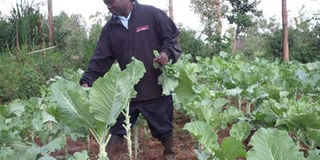Sukuma wiki my darling, my money-maker

Angote harvests kales in his farming garden in Vihiga. PHOTO | ELIZABETH OJINA | NATION MEDIA GROUP
What you need to know:
- Christopher Angote, the owner of the farm, grows about 30,000 plants on his two acres. He spaces them 30cm from one crop to another and 60cm from one row to another.
- He has been farming for the past 25 years having started growing vegetables in 1991 soon after completing Form Four in 1991.
- Prof Mathews Dida, a lecturer at Maseno University’s Department of Agriculture, says downy mildew, a fungal disease characterised by white fluffy mold on the underside of the leaves and yellow dry spots on the upper surface of the leaves, can be transmitted at early stages of the plant in the nursery.
The green leafy sukuma wiki (collard greens) plants stand about half a metre high and sway as the wind blows in Munango village, Vihiga County.
Christopher Angote, the owner of the farm, grows about 30,000 plants on his two acres. He spaces them 30cm from one crop to another and 60cm from one row to another.
A section of the farm hosts various traditional vegetables plants such as black nightshade (managu) and cowpeas (kunde).
“I have tasted the fruits of sukuma wiki and I can say only those who don’t know can despise it as a money-maker. I grow this crop that is widely consumed round-the-year,” says the former teacher, who has partitioned his farm into nine portions.
Angote, who used to teach biology and agriculture at Holy Cross Emalindi Girls Secondary School on contract, is yet to transplant another 20,000 sukuma wiki seedlings of the Southern Georgia variety.
Vendors pick the vegetables packed in 70 and 90kg bags every Tuesdays and Thursdays for sale.
“I sell a sack at between Sh2,000 and Sh4,000, depending on the season, to traders who come to pick them from the farm for sale in Luanda, Ilungu, Chavakali, Mbale, Majengo and Kakamega markets.”
PROFITABLE VENTURE
He says in a week, he collects between Sh20,000 and Sh36,000 from the about nine sacks he harvests.
“Sukuma wiki is profitable because one harvests for up to five months every week as long as you control pests and apply manure. The crop is easy to grow and manage,” offers Angote, who quit teaching to concentrate on farming in 2008.
“I have been farming for the past 25 years having started growing vegetables in 1991 soon after completing Form Four in 1991. I started by planting on quarter acre some 2,000 seedlings and they did well, enabling me to get Sh500 after every three days,” he adds.
He holds a certificate from Kilifi Institute of Agriculture and further trained in farm management at Bukura Institute of Agriculture and Technology in 1997, enabling him to learn the ropes of commercial vegetable farming.
“I start my planting by buying 1kg of seedlings for Sh2,000. I then prepare the nursery bed by adding manure in the soil, which I do a month before buying the seeds and planting.”
The crop takes a month in the nursery after which he transplants them and top dresses with DAP fertiliser. They mature in another one month.
Just as any agribusiness venture, the farmer has a share of challenges ranging from diseases to price fluctuation.
“I once had a bad experience with downy mildew that attacked the seedlings while in the nursery. Luckily, I consulted an agronomist and we sprayed the plants enabling them to survive.”
PESTS AND DISEASES
Stem rot disease, characterised by soft, mucus and smelly rot in the pith of the stem has also affected his sukuma wiki plants.
Prof Mathews Dida, a lecturer at Maseno University’s Department of Agriculture, says downy mildew, a fungal disease characterised by white fluffy mold on the underside of the leaves and yellow dry spots on the upper surface of the leaves, can be transmitted at early stages of the plant in the nursery.
“It is generally favoured by cool and wet weather. The disease is easy to control through spraying of affected areas with Ridomil or Capton pesticides, among other chemicals available in agrovets.”
He says stem rot may occur before or after harvest because of secondary infection from bacteria.
The disease can be prevented through crop rotation and application of Prestop chemical.
****
All season crop
- Sukuma wiki is commercially cultivated for its thick edible leaves.
- The vegetable is available year-round, but are tastier and more nutritious during the rainy season.
- The leaves should be picked before they reach their maximum size.
- Age does not affect flavour and the crop is also much appreciated in South America.
- Fresh sukuma wiki leaves can be stored for between three and 10 days if refrigerated.




